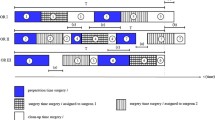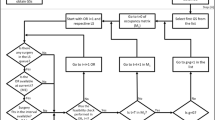Abstract
In this paper we develop a three-phase, hierarchical approach for the weekly scheduling of operating rooms. This approach has been implemented in one of the surgical departments of a public hospital located in Genova (Genoa), Italy. Our aim is to suggest an integrated way of facing surgical activity planning in order to improve overall operating theatre efficiency in terms of overtime and throughput as well as waiting list reduction, while improving department organization. In the first phase we solve a bin packing-like problem in order to select the number of sessions to be weekly scheduled for each ward; the proposed and original selection criterion is based upon an updated priority score taking into proper account both the waiting list of each ward and the reduction of residual ward demand. Then we use a blocked booking method for determining optimal time tables, denoted Master Surgical Schedule (MSS), by defining the assignment between wards and surgery rooms. Lastly, once the MSS has been determined we use the simulation software environment Witness 2004 in order to analyze different sequencings of surgical activities that arise when priority is given on the basis of a) the longest waiting time (LWT), b) the longest processing time (LPT) and c) the shortest processing time (SPT). The resulting simulation models also allow us to outline possible organizational improvements in surgical activity. The results of an extensive computational experimentation pertaining to the studied surgical department are here given and analyzed.
Similar content being viewed by others
References
Blake JT, Carter MW (2002) A goal programming approach to strategic resource allocation in acute care hospitals. Eur J Oper Res 140:541–561
Dexter F, Ledolter J, Wachtel RE (2005) Tactical decision making for selective expansion of operating room resources incorporating financial criteria and uncertainty in sub-specialties’ future workloads. Anesth Analg 100:1425–1432
Blake JT, Dexter F, Donald J (2002) Operating room manager's use of integer programming for assigning block time to surgical groups: a case study. Anesth Analg 94:143–148
Guinet A, Chaabane S (2003) Operating theatre planning. Int J Prod Econ 85:69–81
Ozkarahan I (2000) Allocation of surgeries to operating rooms using goal programming. J Med Syst 24(6):339–378
Sier D, Tobin P, McGurk C (1997) Scheduling surgical procedures. J Oper Res Soc 48:884–891
Sciomachen A, Tanfani E, Testi A (2005) Simulation Models for optimal schedules of operating theatres. Int J Simul 6(12/13):26–34
Harper PR (2002) A framework for operational modeling of hospital resources. Health Care Manage Sci 5:167–173
Dexter F, Traub RD (2002) How to schedule elective surgical cases into specific operating rooms to maximize the efficiency of use of operating room time. Anesth Analg 94:933–942
Dexter F, Macario A, Traub RD (1999) Which algorithm for scheduling add-on elective cases maximizes operating room utilization?. Anesthesiology 91:1491–1500
El-Darzi E, Vasilakis C, Chaussalet T, Millard PH (1998) A simulation modelling approach to evaluating length of stay, occupancy, emptiness and bed blocking in a hospital geriatric department. Health Care Manage Sci 1:143–149
Dexter F, Macario A, O’Neill L (2000) Scheduling surgical cases into over flow block time-computer simulation of the effects of scheduling strategies on operating room labor costs. Anesth Analg 90:980–988
Bowers J, Mould G (2004) Managing uncertainty in orthopaedic trauma theatres. Eur J Oper Res 154:599–608
Tyler DC, Pasquariello CA, Chen CH (2003) Determining optimum operating room utilization. Anesth Analg 96(4):1114–1121
Buchanan D, Wilson B (1996) Re-engineering operating theatres: the perspectives assessed. J Manage Med 10(4):57–74
Spangler WE, Strum DP, Vargas LG, Jerrold HM (2004) Estimating procedure times for surgeries by determining location parameters for the lognormal model. Health Care Manage Sci 7:97–104
May JH, Strum DP, Vargas LG (2000) Fitting the lognormal distribution to surgical procedure times. Decis Sci 31:129–148
Weiss EN (1990) Models for determining estimated start times and case orderings in hospital operating rooms. IIE Trans 22:143–150
Dexter F, Traub RD, Lebowitz P (2001) Scheduling a delay between different surgeons’ cases in the same operating room on the same day using upper prediction bounds for case durations. Anesth Analg 92:943–946
Gerchak Y, Gupta D, Mordechai H (1996) Reservation planning for elective surgery under uncertain demand for emergency surgery. Manage Sci 42:321–334
Gallivan S, Utley M, Treasure T, Valencia O (2002) Booked inpatient admission and hospital capacity: mathematical modelling study. Br Med J 324:280–282
Witness (2004) User guide Lanner Group
Maximal Software, Inc (2000) MPL Modeling System, USA
Kee F, McDonald P, Kirwan JR, Patterson CC, Love AHG (1998) Urgency and priority for cardiac surgery: a clinical judgment analysis. Br Med J 316:925–929
Testi A, Tanfani E (2004) Prioritisation scoring systems for surgical waiting lists. The economics of health reforms. Yfantopoulos J (ed) Athens Institute for Education and Research, Athens, Greece, pp 443–464
Testi A, Tanfani E, Valente R, Ansaldo G, Torre GC (2006) Prioritising surgical waiting list. J Eval Clin Pract, in press
Mullen PM (2003) Prioritising waiting lists: how and why? Eur J Oper Res 150(1):32–45
Law AM, Kelton WD (2000) Simulation modeling and analysis, 3rd. McGraw-Hill, New York
Anderson JG, (2002) Evaluation in health informatics: computer simulation. Comput Biol Med 32:151–164
Rubinstein RY, Melamed B (1998) Modern Simulation and Modeling. Wiley, New York
Kleijnen JPC (1995) Verification and validation of simulation models. Eur J Oper Res 82:145–162
Author information
Authors and Affiliations
Corresponding author
Rights and permissions
About this article
Cite this article
Testi, A., Tanfani, E. & Torre, G. A three-phase approach for operating theatre schedules. Health Care Manage Sci 10, 163–172 (2007). https://doi.org/10.1007/s10729-007-9011-1
Received:
Accepted:
Published:
Issue Date:
DOI: https://doi.org/10.1007/s10729-007-9011-1




